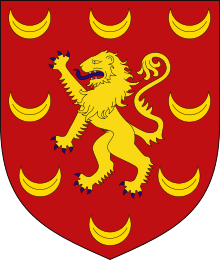Thomas Wentworth Beaumont

Thomas Wentworth Beaumont (5 November 1792 – 20 December 1848)[2] of Bretton Hall, Wakefield in Yorkshire, was a British politician and soldier. In 1831, at the time he inherited his mother's estate, he was the richest commoner in England.[3]
Origins
He was born in Old Burlington Street in Mayfair, London, the eldest son of Thomas Richard Beaumont by his wife Diana Wentworth, daughter of Sir Thomas Wentworth, 5th Baronet.[4]
Career
Beaumont was educated at Eton College and St John's College, Cambridge, where he graduated with a Bachelor of Arts in 1813.[5] He served as lieutenant-colonel of the Northumberland Militia, but resigned in 1824.[4] In 1826, he fought a duel with John Lambton later 1st Earl of Durham.[6] He was president of the Literary Association of the Friends of Poland and a member of the Royal Yacht Squadron.[4]
In 1816 Beaumont stood as Member of Parliament (MP) for Northumberland, the same constituency his father had represented before.[7] He lost this seat in 1826, however was successful for Stafford in a by-election in 1826.[2] After the general election of 1830 Beaumont was returned again for Northumberland, until in 1832, the constituency was split into a north and south division.[7] Beaumont was elected for the latter, and sat then for South Northumberland until his retirement from politic in 1837.[7] Initially a Tory, he was considered a Liberal from 1820.[6]
Marriage & progeny
On 22 November 1827 Beaumont married Henrietta Jane Emma Hawks Atkinson, daughter of John Atkinson,[8] by whom he had two daughters and four sons,[8] including:
- Wentworth Beaumont, 1st Baron Allendale, eldest son and heir, raised to the peerage in 1906;
- Somerset Archibald Beaumont, 3rd son, MP for Newcastle-upon-Tyne and Wakefield.[8]
Death & burial
Beaumont died at the age of 56 at Bournemouth and was buried at his seat Bretton Hall, Wakefield, Yorkshire.[4]
References
- ↑ Montague-Smith, P.W. (ed.), Debrett's Peerage, Baronetage, Knightage and Companionage, Kelly's Directories Ltd, Kingston-upon-Thames, 1968, p.56
- 1 2 "Leigh Rayment - British House of Commons, Stafford". Retrieved 29 April 2009.
- ↑ "The National Archives". Retrieved 29 April 2009.
- 1 2 3 4 Sylvanus, Urban (1849). The Gentleman's Magazine. London: John Bowyer Nicholls and Son. pp. 94–95.
- ↑ "Beaumont, Thomas Wentworth (BMNT809TW)". A Cambridge Alumni Database. University of Cambridge.
- 1 2 Latimer, John (1857). Local Records of Remarkable Events in Northumberland and Durham. p. 254.
- 1 2 3 "Leigh Rayment - British House of Commons, Northumberland & Northumberland South". Retrieved 29 April 2009.
- 1 2 3 "ThePeerage - Thomas Wentworth Beaumont". Retrieved 29 April 2009.
External links
- Hansard 1803–2005: contributions in Parliament by Thomas Wentworth Beaumont
| Parliament of the United Kingdom | ||
|---|---|---|
| Preceded by Sir Charles Monck Thomas Richard Beaumont |
Member of Parliament for Northumberland 1818 – 1826 With: Charles John Brandling |
Succeeded by Matthew Bell Hon. Henry Liddell |
| Preceded by Richard Ironmonger Ralph Benson |
Member of Parliament for Stafford 1826 – 1830 With: Ralph Benson |
Succeeded by John Campbell Thomas Gisborne |
| Preceded by Matthew Bell Hon. Henry Liddell |
Member of Parliament for Northumberland 1830 – 1832 With: Matthew Bell 1830–1831 Viscount Howick 1831–1832 |
Constituency abolished |
| New constituency | Member of Parliament for South Northumberland 1832 – 1837 With: Matthew Bell |
Succeeded by Matthew Bell Christopher Blackett |